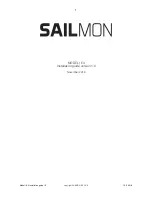
User Manual
V1.0 2021 Copyright Safewaze
8
Upon receiving your Safewaze Full Body Harness, remove the harness from the packaging and fully inspect harness for
possible damage that may have occurred during shipping.
Prior to each use, inspect for the following conditions:
- Inspect the webbing of the harness for cuts, frays, broken stitching, damage from heat or chemical exposure,
or other defects related to excessive wear or abrasion.
- Inspect the harness for indications that it has been exposed to fall arrest forces. All Safewaze FBH’s are
equipped with two load indicators (one on each back torso strap). If either of the load indicators have been
deployed (See Figure 7) remove the FBH from service and dispose of as described in Section 6.5.
- Inspect FBH labeling to ensure that they are legible and present on the harness. If any labeling is illegible,
or missing, remove the FBH from service.
Precautions should be taken in the design and installation of a PFAS in order to avoid hazards such as thermal, chemical,
or electrical hazards. Avoid moving machinery, sharp and/or abrasive edges, and any other hazard that could damage or
degrade components of the PFAS.
Safewaze FBH’s are offered in a variety of configurations to suit a multitude of work environments. The unique features of
a specific FBH may not be suited for all applications. The following are some restrictions that should be considered prior
to use of your Safewaze FBH:
Extended Free Falls:
All Safewaze FBH’s are designed and rated for a maximum free fall of 6 ft. (1.83 m). In
instances where a 12 ft. (3.66 m) is likely, the Safewaze FBH can be used provided that the Safewaze
Energy Absorber Lanyard utilized is rated for extended free falls.
Arborist Use:
Safewaze FBH’s are not designed for, and should never be used in, arborist or tree trimming
applications.
Harsh Chemical Environments:
Work operations in a caustic or acidic chemical hazard environment may
cause damage to your Safewaze FBH. Damage to your FBH due to chemical exposure can, in some instances,
be difficult to detect. In any environment, your Safewaze FBH must be inspected prior to each use, however, a
harsh chemical environment can necessitate more frequent inspections. Care should be taken to inspect your
FBH before, during, and after each use. A harsh chemical environment may also cause a need for more
frequent replacement of your FBH.
Welding, Arc Flash, High Heat Environments:
If work operations are conducted in an environment where
the FBH may be exposed to extremely high temperatures, the user should choose a FBH specifically designed
for these environments. Specific Safewaze FBH’s are available for welding, fire resistantance, and ARC Flash
environments.
Heavyweight:
Although ANSI Z359.11 specifies a weight capacity range of 130 to 310 lbs. (59 to 140 kg), most
Safewaze FBH’s have a maximum weight capacity of 420 lbs. (191 kg). If the user has a weight that exceeds the
ANSI max weight of 310 lbs. (140 kg), it should be ensured that other components of the PFAS are rated for
a heavyweight user.
IMPORTANT:
The components of a PFAS used in conjunction with the Safewaze FBH should meet
the requirements of the ANSI Z359 Fall Protection Code.
11.0 APPLICATION LIMITS
12.0 RESTRICTIONS
13.0 FBH PRE-USE INSPECTION






































